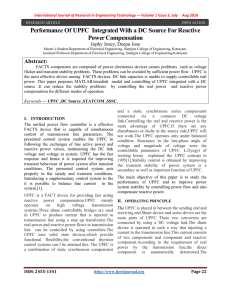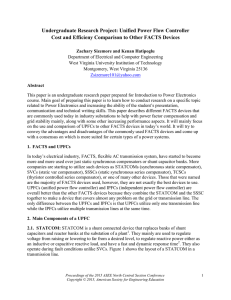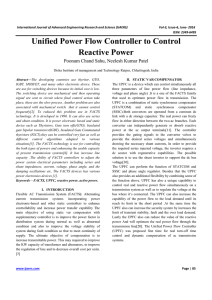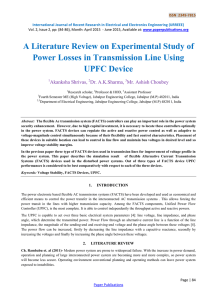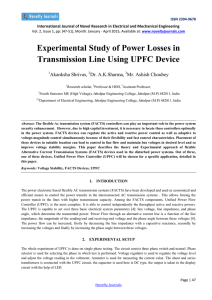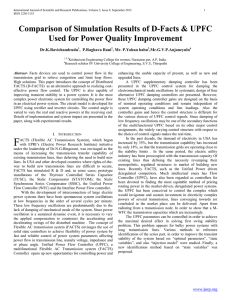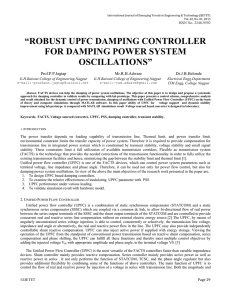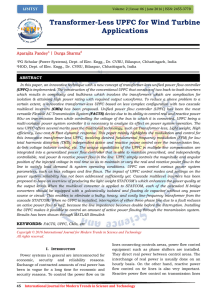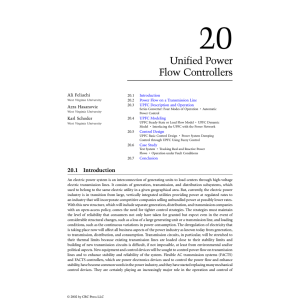Power Flow analysis by Unified Power Flow Controller
advertisement
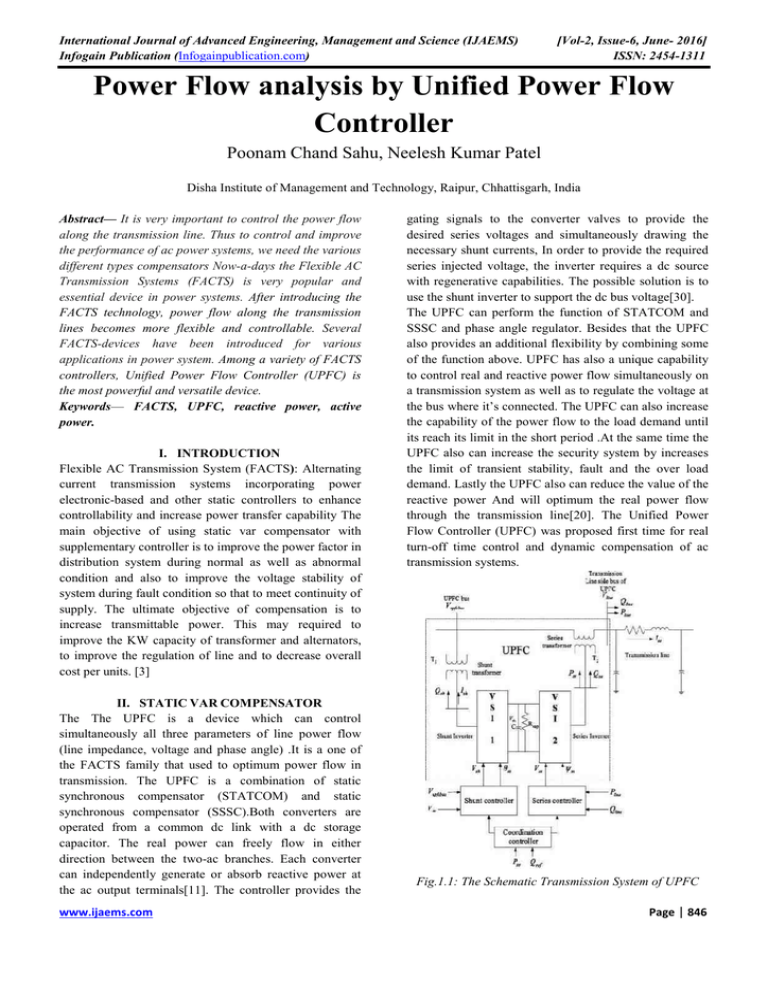
International Journal of Advanced Engineering, Management and Science (IJAEMS) Infogain Publication (Infogainpublication.com) [Vol-2, Issue-6, June- 2016] ISSN: 2454-1311 Power Flow analysis by Unified Power Flow Controller Poonam Chand Sahu, Neelesh Kumar Patel Disha Institute of Management and Technology, Raipur, Chhattisgarh, India Abstract— It is very important to control the power flow along the transmission line. Thus to control and improve the performance of ac power systems, we need the various different types compensators Now-a-days the Flexible AC Transmission Systems (FACTS) is very popular and essential device in power systems. After introducing the FACTS technology, power flow along the transmission lines becomes more flexible and controllable. Several FACTS-devices have been introduced for various applications in power system. Among a variety of FACTS controllers, Unified Power Flow Controller (UPFC) is the most powerful and versatile device. Keywords— FACTS, UPFC, reactive power, active power. I. INTRODUCTION Flexible AC Transmission System (FACTS): Alternating current transmission systems incorporating power electronic-based and other static controllers to enhance controllability and increase power transfer capability The main objective of using static var compensator with supplementary controller is to improve the power factor in distribution system during normal as well as abnormal condition and also to improve the voltage stability of system during fault condition so that to meet continuity of supply. The ultimate objective of compensation is to increase transmittable power. This may required to improve the KW capacity of transformer and alternators, to improve the regulation of line and to decrease overall cost per units. [3] II. STATIC VAR COMPENSATOR The The UPFC is a device which can control simultaneously all three parameters of line power flow (line impedance, voltage and phase angle) .It is a one of the FACTS family that used to optimum power flow in transmission. The UPFC is a combination of static synchronous compensator (STATCOM) and static synchronous compensator (SSSC).Both converters are operated from a common dc link with a dc storage capacitor. The real power can freely flow in either direction between the two-ac branches. Each converter can independently generate or absorb reactive power at the ac output terminals[11]. The controller provides the www.ijaems.com gating signals to the converter valves to provide the desired series voltages and simultaneously drawing the necessary shunt currents, In order to provide the required series injected voltage, the inverter requires a dc source with regenerative capabilities. The possible solution is to use the shunt inverter to support the dc bus voltage[30]. The UPFC can perform the function of STATCOM and SSSC and phase angle regulator. Besides that the UPFC also provides an additional flexibility by combining some of the function above. UPFC has also a unique capability to control real and reactive power flow simultaneously on a transmission system as well as to regulate the voltage at the bus where it’s connected. The UPFC can also increase the capability of the power flow to the load demand until its reach its limit in the short period .At the same time the UPFC also can increase the security system by increases the limit of transient stability, fault and the over load demand. Lastly the UPFC also can reduce the value of the reactive power And will optimum the real power flow through the transmission line[20]. The Unified Power Flow Controller (UPFC) was proposed first time for real turn-off time control and dynamic compensation of ac transmission systems. Fig.1.1: The Schematic Transmission System of UPFC Page | 846 International Journal of Advanced Engineering, Management and Science (IJAEMS) Infogain Publication (Infogainpublication.com Infogainpublication.com)) [Vol-2, Issue-6, June- 2016] ISSN: 2454-1311 Fig.1.1 shows the Unified Power Flow Controller is consists of two switching converters [18][25]. Which are considered as voltage sourced inverters using gate thyristor valves, as illustrated in. These inverters, labeled "VSC1” and "VSC2" in the figure are operated with a common dc link provided by a dcc storage capacitor. With this arrangement the ac power converter in which the real power can freely flow in either direction between the ac terminals of the two inverters and each inverter can independently generate as well as absorb the reactive power at its own ac output terminal .Since the series converter of the UPFC can inject a voltage with variable magnitude and phase angle it can exchange real power with the transmission line with the help of series transformer. However a UPFC as a whole (both converter) erter) cannot supply or absorb real power in steady state (except for the power drawn to compensate for the losses).Unless it has a power source at DC terminals. Thus the shunt branch is required for compensate (from the system for any real power drawn/supplied drawn/sup by the series branch and the losses. when the power balance is not maintained, at that situation the capacitor cannot remain at a constant voltage. Shunt branch also can independently exchange reactive power with the system[31]. The Unified Power Flow w Controller from the stand point of conventional power transmission based on reactive series compensation, shunt compensation, and phase shifting, the UPFC is the only device which can fulfill all these functions and thereby meet multiple control objectives es by adding the injected voltage Vpq, with appropriate amplitude and phase angle, to the terminal voltage Vo Using phasor representation, the basic UPFC power flow control functions are illustrated in Fig. 1.2 [20]. Fig.1.2 is shown terminal voltage regulation, similar to that obtainable with a transformer tap-changer tap having infinitely small steps[18][34]. teps[18][34]. It is shown at (a) where Vm=ΔV V (boldface letters represent phasors) is injected in-phase (or anti-phase) phase) with Vo. Series capacitive compensation is shown at (b) where Vm= Vc is injected in quadrature with the line current I. I Transmission angle regulation (Phase shifting) is shown at (c) where Vpq= Vσ is injected with an angular relationship with respect to Vo that achieves the desired σ phase shift (advance or retard) without any change in magnitude[20]. Vpq=ΔV+ ΔV+ Vc + Vσ The shunt converter draws ws a controlled current from the system. One component of this current is Ip which is automatically determined by the requirement to balance the real power supplied to the series converter through the DC link. This power balance is enforced by regulating the t DC capacitor voltage by feedback control[17].The other component of the shunt converter current is the reactive current, Ir which can be controlled in a similar fashion as in a STATCOM. There are two operating (control) modes for a STATCOM or the shunt converter. These are, VAR control mode where the reactive current reference is determined by the inductive or capacitive VAR command. The feedback signals are obtained from current transformers (CT) typically located on the bushings of the coupling (step down) own) transformer[17][30].Automatic voltage control mode where the reactive current reference is determined by the output of the feedback voltage controller which incorporates a droop characteristic (as in the case of a SVC or a STATCOM). The voltage feedback ck signals are obtained from potential transformers (PT) measuring the voltage V1 at the substation feeding the coupling transformer [17]. Fig.1.2 Basic UPFC control function. (a)Voltage Regulation (b) Series compensation (c) Angle regulation (d) Multi-function function power flow controller Fig.1.3: Block diagram of shunt VSC controller III. ACTIVE AND REACTIVE POWER CONTROL BY UPFC In figure (4.14) a simple two machine (or two bus ac inertia) system with sending-end sending voltage Vs, receiving- www.ijaems.com Page | 847 International Journal of Advanced Engineering, Management and Science (IJAEMS) Infogain Publication (Infogainpublication.com Infogainpublication.com)) end voltage Vr, and line (or tie) impedance X (assumed, for simplicity, inductive) is shown. At (b) the voltages of the system in form of a phasor diagram are shown with transmission angle δ and Vs = Vr = V. At the receiving ends of the line the transmitted active and reactive power are P=V2/X sinδ and Q =Qs = Qr= V2/X (1 − cosδ)[20]. Fig.1.4: (a) Simple two machine system (b) Related voltage phasors Fig.1.4(a) and (b) are show the basic power system of with the known transmission characteristics is introduced to providing a vehicle to establish the capability of the UPFC to control the transmitted tted real power P and the reactive power demands, Qs, and Qs,at the sending-end sending and, respectively, the receiving-end end of the line[17][18]. [Vol-2, Issue-6, June- 2016] ISSN: 2454-1311 series with the line which, can generate or absorb reactive power that it negotiates with the line, but the real power it exchanges must be supplied to it, or absorbed from it, by the sending-end end generator .The voltage which is injected by the UPFC in series with the line is represented by phasor V, having magnitude Vpq (0≤ (0 Vpq ≤0.5 p. u) and angle ρ (0≤ρ≤360°)measured 360°)measured from the given phase position of phasor as illustrated in the figure. The line current is represented by phasor I, I flows through the series voltage source, Vpq and generally generall results in both reactive and real power exchange IV. MATLAB LAB SIMULATION The model of UPFC. Voltage source is connected to transmission line. In transmission has connected to three phase transformer. It other side is also connected three transformer in series connection. It has two inverter are connected, they are STATCOM and SSSC. Where Wher STATCOM is control active power and reactive power and SSSC is control the voltage magnitude and phase angle.In UPFC controlling is done by the both VSC devices, state and is control by SSSC. It is use gate pulse generator circuit because controlling of gate pulse generator circuit is easy. In gate pulse generator circuit input voltage and firing angle where compared and then send its output to gate pulse Thyristor.It series shunt type of FACTS devices. It easy to control as compare to capacitor and other her active device. STATCOM is only control to active and reactive power and SSSC is only control to voltage magnitude and phase angle between voltage and current. So we use UPFC because it is a combination of both STATCOM and SSSC. Fig.1.6:UPFC simulation modal Fig.1.5: Two-machine machine system with the Unified Power Flow Controller Fig.1.5 are show two-machine machine system with the Unified Uni Power Flow Controller[1][37]. Consider Fig.1.5 where the simple power system of Fig.1.4 is expanded to include the UPFC. In the previous section explained that he UPFC is represented by a controllable voltage source in www.ijaems.com V. RESULTS AND DISCUSSION In this simulation model both active and reactive power are analyzed. In domestic and industries large inductive loads are used which consumes heavy reactive power. So there is a essential requirement of reactive power po compensation. Reactive power can be compensated using Page | 848 International Journal of Advanced Engineering, Management and Science (IJAEMS) Infogain Publication (Infogainpublication.com Infogainpublication.com)) FACT devices but controlling of these devices are complex, while UPFC is easy to control. [Vol-2, Issue-6, June- 2016] ISSN: 2454-1311 [8] B. Vijay Kumar a, N.V. Srikanth "Optimal location and sizing of Unified Power Flow Controller (UPFC) to improve dynamic stability: sta A hybrid technique", IJAREEIE, 2014. [9] Arindam Ghosh, Gerard Ledwich, Ledwich “Power Quality Enhancement Using Custom Power Devices”, 2002. Fig.1.7: Active and Reactive Power without UPFC Fig.1.8: Active and Reactive Power with UPFC REFERENCES [1] G.Hingorani and L.Gyugyi “Understanding FACTS: Concepts and Technology of Flexible AC Transmission Systems”, IEEE,1999. [2] Keri, A.J.F Mehraban, A.S. ; Lombard, X. ; Eiriachy, A. “Unified Unified power flow controller (UPFC): modeling and analysis”, IEEE,1999 [3] B.Gopinath, S.Suresh Kumar, Juvan Michael “Unified Power Flow Controller (UPFC) for Dynamic Stability in Power System using Modern Control Technique” IJEAT, 2014. [4] Md. Habibur Rahman , Md. Harun-Or Or-Rashid, Sohel Hossain "Stability Improvement of Power System By Using PSC Controlled UPFC", IJSETR, 2013. [5] Vaibhav S Kale, Prashant R Patil, Ravi Khatri "Unified Power Flow Controller for POWER SYSTEMImprovement", IJESE, 2010. [6] P.Pavan Kumar N.Poornachandrarao "Improvement of power flow in the power system network by using UPFC device", IJERA, 2012. [7] B.Gopinath, Dr.S.Suresh Kumar, S.Mohanapriya "An Intelligent Technique For Unified Power Flow Controller With Matrix Converter", IJSRP, 2013. www.ijaems.com Page | 849

